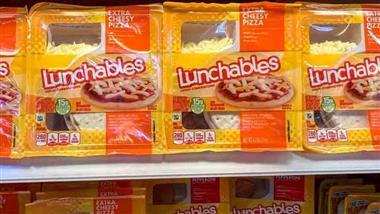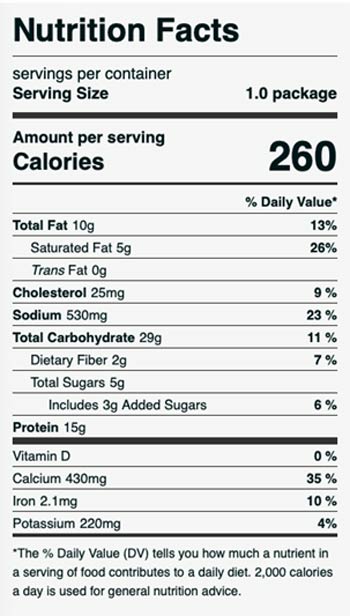by Dr. Joseph Mercola, Mercola:

STORY AT-A-GLANCE
- Two Kraft Heinz ready-to-eat prepackaged Lunchables are being added to K-12 school lunch programs across the U.S. this fall
- Kraft Heinz — which is primarily owned by institutional shareholders, the top four being Berkshire Hathaway, BlackRock, Vanguard and State Street — is a partner of the School Nutrition Association, and has been pushing to get their wares into the lunch program for some time
TRUTH LIVES on at https://sgtreport.tv/
- According to Katie Wilson, executive director of the Urban School Food Alliance, the fact that a processed, packaged food meets school lunch standards points to problems with the federal nutritional guidelines
- Topping my list of concerns for the Lunchables extra cheese pizza product is the presence of soybean oil, which is loaded with harmful omega-6 linoleic acid (LA). Evidence suggests LA is a key contributor to chronic diseases, as it impairs mitochondrial function and energy production
- “Vital wheat gluten” is another concern. This is pure gluten, which can contribute to or cause leaky gut. Other questionable ingredients include artificial flavors, preservatives, food coloring and “cellulose powder,” which is a fancy name for refined wood pulp. In addition to being an anticaking agent, wood pulp also provides bulk (cutting down on the amount of “real” ingredients required) and can have a laxative effect in sufficient quantity
The quality of school lunches has been deteriorating for decades, and it just got another downgrade. As reported by CNN,1 two Kraft Heinz ready-to-eat prepackaged Lunchables are being added to K-12 school lunch programs across the U.S. as of this fall semester.
Improved Nutrition?
The school Lunchables have reportedly been reformulated to meet the National School Lunch Program’s (NSLP) nutritional requirements, which include higher grain content and lower sodium, compared to the Lunchables sold in stores.
But if you have even the slightest knowledge about diet and nutrition, you’ll realize that NSLP nutritional requirements really don’t amount to much. They certainly do not guarantee that your children are being well-fed.
Schools are required to offer students five meal components: fruit, vegetable, protein, grain and milk, and students must take at least three, including a fruit or vegetable option, as part of their lunch.
While that seems sound, once you start looking at what qualifies as fruit, vegetable, protein, grain and milk, you quickly realize that what the kids are actually getting is ultraprocessed junk food loaded with artificial ingredients.
Pizza, for example, has been a staple in schools for a long time, with tomato sauce qualifying as “vegetable.” The Lunchables “extra cheesy pizza” isn’t even regular pizza. It’s basically an ultraprocessed imitation of an ultraprocessed junk food.
Not surprisingly, Kraft Heinz is a partner of the School Nutrition Association, and has reportedly been pushing to get their wares into the lunch program for some time.2
Meanwhile, the Kraft Heinz Company is primarily owned by institutional shareholders.3 As of this writing, the top four owners are Berkshire Hathaway, BlackRock, Vanguard and State Street4 — the same entities that have a monopoly on the world’s resources in general.
Balanced Nutrition?
Kraft Heinz has also partnered with Del Monte to provide a Lunchables with Fresh Fruit option, where the processed lunch meat and cheese is served with pieces of fruit (apples, pineapple, grapes or clementines) rather than crackers.
According to foodsided.com,5 the fruit-based Lunchables is an effort to create a more “balanced eating school lunch option.”
These products are not being rolled out as part of the school lunch program, however. They’ll be available in grocery stores across the South-Central region of the U.S. this fall, and are being marketed to children who bring their own lunches.
Lunchables Raise Concern Among Child Nutritionists
According to The Washington Post,6 the new Lunchables offerings “could appeal to schools that are struggling with labor shortages in cafeterias and supply chain kinks that have limited their menu options.” However, “many nutrition experts greeted the news with a heaping side of skepticism” — as they well should. The Washington Post writes:7
“Katie Wilson, the executive director of the Urban School Food Alliance, said the approval of Lunchables points to bigger problems with federal guidelines. ‘The fact that a processed, packaged food meets school lunch standards is part of what needs to change in the national school lunch program,’ she said …
Dariush Mozaffarian, a cardiologist and professor at the Tufts Friedman School of Nutrition, said he wouldn’t have a problem with Lunchables — if they didn’t include processed meat or high sodium levels.
The World Health Organization considers products such as sandwich meats, hot dogs and bacon to be ‘Group 1’ carcinogens, the same category as cigarettes and asbestos, he noted …
‘These are products that could be used in an emergency situation, but I certainly hope they don’t become the norm in school meals,’ Wilson said. ‘What message are we sending our children about healthy eating?’ And then there’s the packaging — plastic trays and wrappers — which some critics say is wasteful.”
Plastic Contamination — Another Pressing Concern
Indeed, each Lunchables product comes in a plastic tray with plastic wrap cover, so just how much plastic trash will be added by serving Lunchables to 30 million students, every day of the school year?
Without getting bogged down in actual math, we can conclude it’s going to be quite a lot, so where’s the environmental concern? Aren’t we eliminating livestock and cutting agriculture to save the planet? Shouldn’t we leave the cows and rice paddies alone and eliminate processed foods wrapped in plastic instead?
Both food and water are becoming increasingly contaminated with these toxic bits. Microplastic particles, which are less than 5 millimeters long, are literally clouding the oceans in spots.
Carried along with the ocean’s currents, swirling gyres of “plastic smog”8 now cover about 40% of the world’s ocean surfaces.9 Plastic bits are eaten by fish and other marine life, which are then eaten by us.10
Remarkably, the annual release of plastics to land is estimated to be four to 23 times greater than that released to oceans.11 Eighty-three percent of tap water samples tested worldwide, and 94% of samples in the U.S., are also contaminated with plastic.12
Pure Garbage
While media report the content of these Lunchables in terms of the amounts of grains, meat/meat alternatives, saturated fat and sodium in them, most nutritionally-aware people know that there’s more to nutrition than that. Just what is in these products?
Here’s the Nutrition Facts label and list of ingredients for the Lunchables Extra Cheesy Pizza (4.2-ounce package) sold in U.S. grocery stores:13
 |
 |
The school lunch program version comes in a 5.05-ounce container and is formulated to contain 2 ounces of meat/meat alternative, 2 ounces of grains, one-eighth cup of red vegetable (tomato sauce), 7 grams of saturated fat and 700 milligrams of sodium.
Aside from those details, I’ve not been able to locate a full list of ingredients for the school version, but I believe it’s reasonable to assume that most of the individual ingredients will be the same as the grocery store version.



